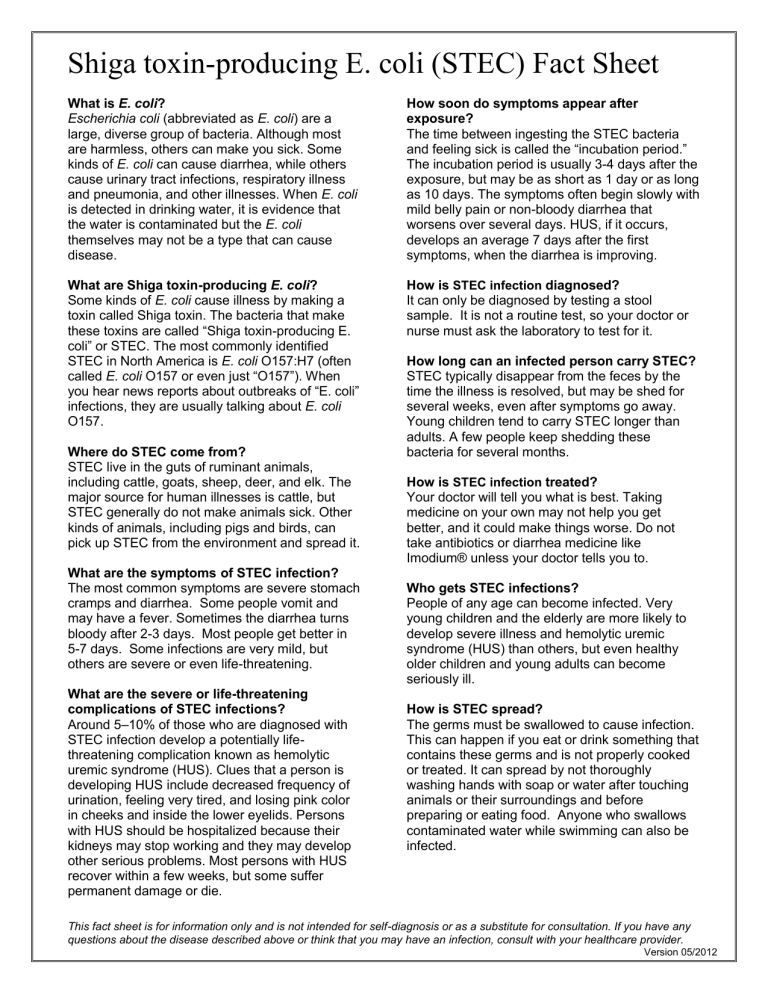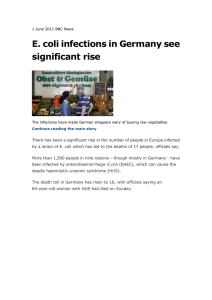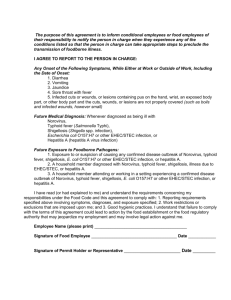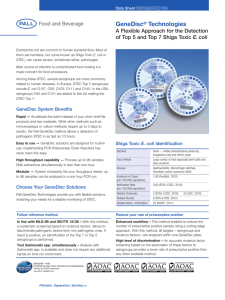
Shiga toxin-producing E. coli (STEC) Fact Sheet What is E. coli? Escherichia coli (abbreviated as E. coli) are a large, diverse group of bacteria. Although most are harmless, others can make you sick. Some kinds of E. coli can cause diarrhea, while others cause urinary tract infections, respiratory illness and pneumonia, and other illnesses. When E. coli is detected in drinking water, it is evidence that the water is contaminated but the E. coli themselves may not be a type that can cause disease. How soon do symptoms appear after exposure? The time between ingesting the STEC bacteria and feeling sick is called the “incubation period.” The incubation period is usually 3-4 days after the exposure, but may be as short as 1 day or as long as 10 days. The symptoms often begin slowly with mild belly pain or non-bloody diarrhea that worsens over several days. HUS, if it occurs, develops an average 7 days after the first symptoms, when the diarrhea is improving. What are Shiga toxin-producing E. coli? Some kinds of E. coli cause illness by making a toxin called Shiga toxin. The bacteria that make these toxins are called “Shiga toxin-producing E. coli” or STEC. The most commonly identified STEC in North America is E. coli O157:H7 (often called E. coli O157 or even just “O157”). When you hear news reports about outbreaks of “E. coli” infections, they are usually talking about E. coli O157. How is STEC infection diagnosed? It can only be diagnosed by testing a stool sample. It is not a routine test, so your doctor or nurse must ask the laboratory to test for it. Where do STEC come from? STEC live in the guts of ruminant animals, including cattle, goats, sheep, deer, and elk. The major source for human illnesses is cattle, but STEC generally do not make animals sick. Other kinds of animals, including pigs and birds, can pick up STEC from the environment and spread it. What are the symptoms of STEC infection? The most common symptoms are severe stomach cramps and diarrhea. Some people vomit and may have a fever. Sometimes the diarrhea turns bloody after 2-3 days. Most people get better in 5-7 days. Some infections are very mild, but others are severe or even life-threatening. What are the severe or life-threatening complications of STEC infections? Around 5–10% of those who are diagnosed with STEC infection develop a potentially lifethreatening complication known as hemolytic uremic syndrome (HUS). Clues that a person is developing HUS include decreased frequency of urination, feeling very tired, and losing pink color in cheeks and inside the lower eyelids. Persons with HUS should be hospitalized because their kidneys may stop working and they may develop other serious problems. Most persons with HUS recover within a few weeks, but some suffer permanent damage or die. How long can an infected person carry STEC? STEC typically disappear from the feces by the time the illness is resolved, but may be shed for several weeks, even after symptoms go away. Young children tend to carry STEC longer than adults. A few people keep shedding these bacteria for several months. How is STEC infection treated? Your doctor will tell you what is best. Taking medicine on your own may not help you get better, and it could make things worse. Do not take antibiotics or diarrhea medicine like Imodium® unless your doctor tells you to. Who gets STEC infections? People of any age can become infected. Very young children and the elderly are more likely to develop severe illness and hemolytic uremic syndrome (HUS) than others, but even healthy older children and young adults can become seriously ill. How is STEC spread? The germs must be swallowed to cause infection. This can happen if you eat or drink something that contains these germs and is not properly cooked or treated. It can spread by not thoroughly washing hands with soap or water after touching animals or their surroundings and before preparing or eating food. Anyone who swallows contaminated water while swimming can also be infected. This fact sheet is for information only and is not intended for self-diagnosis or as a substitute for consultation. If you have any questions about the disease described above or think that you may have an infection, consult with your healthcare provider. Version 05/2012 Shiga toxin-producing E. coli (STEC) Fact Sheet How can you prevent STEC or E. coli 0157 infections? Remember that E. coli can only make you sick if you ingest them, and that it can be killed thorough cooking. Some general guidelines include: WASH YOUR HANDS thoroughly after using the bathroom or changing diapers and before preparing or eating food. WASH YOUR HANDS after contact with animals or their environments (at farms, petting zoos, fairs, even your own backyard). COOK meats thoroughly. Ground beef and meat that has been needle-tenderized should be cooked to a temperature of at least 160°F (70˚C). It’s best to use a thermometer, as color is not a reliable indicator. AVOID raw milk, unpasteurized dairy products, and unpasteurized juices (like fresh apple cider). AVOID swallowing water when swimming or playing in lakes, ponds, streams, swimming pools, and backyard “kiddie” pools. Those who have been ill can spread illness to others if they do not wait until 2 weeks after their diarrhea has stopped before swimming or playing in these places. PREVENT cross contamination in food preparation areas by washing hands, counters, cutting boards, and utensils after they touch raw meat. Are there any restrictions for people with STEC or E. coli 0157 infections? Children diagnosed with STEC or E. coli 0157 must also be excluded from daycare until diarrhea has ceased and they no longer have STEC or E. coli 0157 in their stools (two negative stool cultures). Workers involved in food handling, patient care, and any occupation involving the care of young children and the elderly, are also not allowed to work until they no longer have STEC or E. coli 0157 in their stools (two negative stool cultures). Workers in food-related businesses exposed to STEC or E. coli 0157 either through an infected household member or food should also be restricted from handling food until 3 days after their exposure. Other recommendations are that infected adults and children with diarrhea caused by this pathogen should not use recreational water venues (i.e., pools, slides) until their symptoms have resolved for 2 weeks, and people with diarrhea should not go to school or work until symptoms resolve. Where can I get more information? www.cdc.gov/health/default.htm This fact sheet is for information only and is not intended for self-diagnosis or as a substitute for consultation. If you have any questions about the disease described above or think that you may have an infection, consult with your healthcare provider. Version 05/2012






